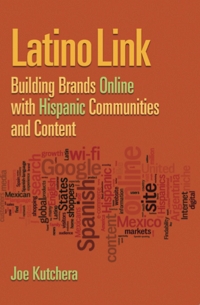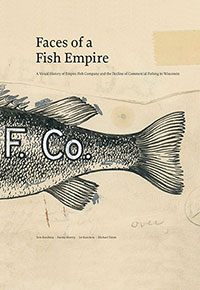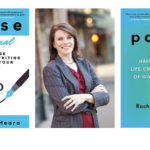This is the third in a three-part series on how to write, edit and promote a book, based on my experience of writing my first book. Read Part I (on how to pitch your book and find a publisher) and Part II (on how to write and edit your book).
“Thankfully, persistence is a great substitute for talent,” Steve Martin said after releasing his 8th book, An Object of Beauty.
Writing a book requires a great deal of persistence. But what about promoting it? I was surprised by how much persistence and work was needed after my book was completed. That’s what this third post in my series is about: how to promote your book using social media.
Don’t Take a Vacation
I met business author Jill Konrath who made a great analogy about the importance of promoting her books. “A book is like a child. Once your child is conceived and born, you have to raise it. That’s where the real work begins.” She is the author of SNAP Selling, Get Back to Work Faster, and Selling to Big Companies.
Authors consistently shock Allison McLean, the Associate Director of Publicity at Portfolio Books (Part of the Penguin Group), by taking a vacation right when their books come out. She says, “Your job starts when you turn in the final manuscript.”
“There’s a misconception among authors that once you turn in your manuscript, that’s it,” McLean said. “The responsibility of marketing a book falls squarely on the shoulders of an author. If you don’t take care of it, nobody else will. Most successful authors actively get involved in marketing their book and carefully plan the promotions.”
While I carefully planned my book tour and promotions months in advance of Latino Link’s release date, I have to admit that I thought much the same way. I naively believed that the speaking invitations and press mentions would simply flow in after my book came out. And hey, I was ready for a vacation after writing and editing my book 24/7 for one year. With 2500 books published every day, promoting your book requires just as much work and dedication as writing your book does, or perhaps even more. It feels like what my grandfather used to tell me, “The harder I work, the luckier I get.”
How can you get your book on the New York Times best sellers list like Chris Brogan did with his book Trust Agents? Jack Covert, the founder of 800-CEO-READ (now Porchlight Books), suggests that authors shouldn’t worry about getting on the best-selling lists. “Focus on selling books. Then, you might actually get on a list,” he says. For example, offer sales incentives. When corporations or MBA classes buy 10 books, offer two free additional copies. Covert also suggests giving away your book as your business card. Don’t sell books in the back of the room. Bake your books into the price of your speaking gigs and give one to all attendees at corporate talks or conferences.
Hire a Publicist and Tips on Pitching the Press
When pitching media outlets, Mike Hoffman from Inc.com, suggests answering questions like: What new ideas does your book bring to the conversation? How does your book provide a new way of looking at a business problem today?
In addition, he recommends reading the magazines and websites that you want to pitch six to seven months before your book comes out. Who writes your favorite columns? Which writers cover your niche? When Latino Link launched, I had already been in touch with a number of the Hispanic and digital media trade reporters. So, when I gave them my book, I landed some nice coverage on Laura Martinez’ blog on Advertising Age and Portada, a Hispanic and Latin American media trade journal, for example.
“Always hire a freelance publicist,” Allison McLean from Penguin’s Portfolio label advises. My book-writing mentor at Hachette Book Group recommended Rob Nissen who has worked on books like On the Brink by Henry Paulson, Exporting America by Lou Dobbs, and The Mirror Test by Jeffrey Hayzlett. Once you have one lined up, you and your publicist should send copies of your book to columnists, the experts you quoted, bloggers, colleagues in your industry, and respected professionals who will write a positive review on Amazon. Just as with cereal or toothpaste, sampling works. A free book gets people talking and recommending yours (provided of course that it’s well-written).
For her book Fascinate: Your 7 Triggers to Persuasion and Captivation, author Sally Hogshead didn’t just send the book out. She designed and produced a Fascinate kit, which included her book and seven items that represented the seven tips to fascinate readers, as outlined in her book. Her website includes her “Fascinate Test,” the first personality profiling tool to show you how the world sees you.
How did I get Seth Godin to endorse my book? I asked my mentor during the book-writing process, an SVP at Hachette Book Group, about how to get someone like Seth Godin or Malcom Gladwell to endorse my book. She told me, “I sit next to Seth’s agent on the train everyday. I can ask her for you.” Within a few days, my mentor connected me to his agent and shortly thereafter I received an email directly from Seth himself saying he would need to see the whole manuscript. About two weeks after I mailed it to him, he emailed me his endorsement.
Side note: here’s an interesting article about Seth Godin’s self-publishing venture on TechCrunch. And here’s his blog post on his “Domino Project.”
Organizing a Book Tour
During the early stages of writing my book, I was already well underway in planning my book tour. A former colleague, Mariana Chavez, assisted me in emailing and calling the marketing conferences and universities that formed the backbone of my book tour (about 15 events across the country). Thanks to Mariana’s persistence, and months of planning, I landed presentations at numerous conferences just as my book came out, which helped build a wave of awareness and book sales.
Mariana also reached out to numerous universities, which can be great places to practice speaking and try out new presentation concepts. When my book came out, I spoke at NYU, Fordham, DePaul, Marquette, and Florida State Universities. Having an assistant helped me organize my book tour and make it a success.
Catalyst Ranch, a creative meeting and event space in downtown Chicago, hosted my book launch party in Chicago. Thanks to our co-promotion of the event via email, LinkedIn, Twitter, and Facebook, we had a full house of attendees. Eva Niewiadomski, used to work at Quaker Oats and promotes the Ranch’s author events via her impressive database of Chicago-based clients like Kraft, MillerCoors, Allstate, Hyatt, US Cellular, Dyson, and The Tribune Company. Eva connected me to the Hispanic ad agency, Paco Communications, who sponsored the margaritas for my fiesta. Hoy, Chicago’s Spanish-language newspaper (part of the Tribune Company), sponsored the tasty Mexican food and MillerCoors graciously provided the beer. All in all, the party required a lot of work to organize but the great turn out made it worthwhile. Catalyst Ranch provides authors with a great platform for their Chicago book launch event. Or, if you simply want to learn about the latest business insights, I highly recommend attending its author series.
One additional idea: Reach out to business book discussion groups on LinkedIn and MeetUp.com to offer discounted copies of my book and join them for the book conversation.
Organizing Your Blog (Video) Tour
When I asked a producer at The Today Show, “How do you get ideas for the segments that you produce?” She said, “I mostly look at local media outlets and blogs for ideas. I rarely take ideas from publicists.” With that philosophy in mind, I organized a blog tour thinking that every blogger, no matter how small, could magnify the message about my book. They could increase awareness of my book through their readers as well as provide a potential stepping-stone to a larger media outlet. The biggest lesson here was in developing relationships with each blogger/influencer and continuing to read their blogs.
Fortunately, I had a great example to follow. Aaron Goldman developed an amazingly well-produced series of customized videos for each stop of his blog tour with his publisher, McGraw-Hill. Following Aaron’s example, I got to know some fantastic entrepreneurs and bloggers prior to my blog tour. Later, after getting to know the bloggers/entrepreneurs, I secured a number of posts/reviews about my book on their blogs where they included a video summary my book. Here’s an example of my video summary:
One of the first bloggers I met on my book tour was Miguel Corona. I gave him a copy of my book at the Center for Hispanic Leadership’s conference after which he posted a video review. I promptly re-posted his review on my Amazon author page. And my publisher, Paramount Books, posted the video in their newsletter as well. It was a win-win for both Miguel and me.
The social media wunderkind, Frankie DeSoto, reviewed Latino Link on his blog and posted this in-person interview with me after the University of North Texas’ Spanish-language media conference:
Should you develop a Facebook page for your book? My friend Rachel Yeomans (Digital Experience Leader at @SaatchiNewYork) recommends starting a community around the theme of your book so that you and the group members can keep the conversation alive. In contrast, book-only Facebook pages tend to be forgotten about months after the launch of the book and look that way (which obviously doesn’t look good). In contrast, a group like Frankie DeSoto’s Hispanic Marketing and Online Media on Facebook is continuously updated with new and relevant content links that keeps the community engaged.
Why should you read and comment on other blogs related to the theme of your book? I left a comment on Elena del Valle’s blog – Hispanic Marketing & Public Relations – and a few months later I received an email from one of the editors at Fox News Latino. She discovered my comment on a post there, clicked on the link to my site, and shot me an email asking me to write this story for them. It ended up becoming my biggest hit on Twitter.
In summary, you can follow these steps to develop content and incorporate SEO and social to drive links and social promotion of your book:
- Write a memorable/unique book
- Regularly post content across your social media channels
- Promote your content via social media
- Build reach via those social media channels
- Nurture your relationships online and in-person
- Analyze the results
- Optimize the content and flow over time
The End (And a New Beginning)
In conclusion, once you write your book, you face the question of how to monetize what you just created. Will it drive client engagements for your company? Or will it bring consulting and speaking gigs? This article, from Inc Magazine, features Josh Shipp, writer, mentor and professional speaker on The Art and Business of Motivational Speaking.
For me, it led me to a new full-time opportunity. After giving a keynote presentation at a conference in Miami, the CEO of Acento, Roberto Orcí, invited me to do a workshop at his agency around the theme of my book. Following that workshop and a series of interviews, I became the ad agency.’s digital director at its Los Angeles headquarters.
So, how did my book do? Steve Martin sums up my feelings on the subject perfectly. “I think I did pretty well, considering I started out with nothing but a bunch of blank paper.”
Continue reading my tips on how to write, edit and promote a book in Part I (on how to pitch your book and find a publisher) and Part II (on how to write and edit your book).







